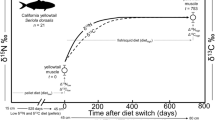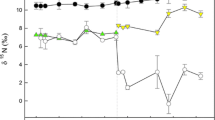Abstract
The objective of this study was to measure the tissue-specific response of isotope δ15N to changes in isotopic signature of diet in an adult Pacific herring, Clupea pallasi, and to examine the importance of growth and metabolism in this shift. This was accomplished by placing wild adult Pacific herring in captivity and monitoring isotopic shift in tissues with a corresponding isotopic shift in diet, and the application of a metabolism/growth mixing model. Tissues examined were blood, eye, heart, liver, and white muscle. One group of herring was given a δ15N diet depleted by approximately 5.4‰, and another given a 15N-enriched diet labeled with 98 atom% l-phenylalanine. This study showed that (i) isotopic response of individual tissues following an isotopic shift in diet varied in both rate of change and fractionation level, (ii) most of this isotopic shift is due to growth, and (iii) white muscle and liver tissue appeared the most responsive to isotopic shift in diet, reaching isotopic equilibrium with diet in a matter of months (not years). For trophic studies using δ15N, these results indicate that field measurement of Pacific herring should be done after much of summer growth has occurred.
Similar content being viewed by others
References
Adams TS, Sterner RW (2000) The effect of dietary nitrogen content on trophic level δ15N enrichment. Limnol Oceanogr 45:601–607
Bosley KL, Witting DA, Chambers RC, Wainright SC (2002) Estimating turnover rates of carbon and nitrogen in recently metamorphosed winter flounder Pseudopleuronectes americanus with stable isotopes. Mar Ecol Prog Ser 236:233–240
Carter CG, Houlihan DF, Buchanan B, Mitchell AI (1993) Protein–nitrogen flux and protein growth efficiency of individual Atlantic salmon (Salmo salar L.). Fish Physiol Biochem 12:305–315
Dahl TM, Falk-Petersen S, Gabrielsen GW, Sargent JR, Hop H, Millar RM (2003) Lipids and stable isotopes in common eider, black-legged kittiwake and northern fulmar: a trophic study from an Arctic fjord. Mar Ecol Prog Ser 256:257–269
Doucett RR, Booth RK, Power G, McKinley RS (1999) Effects of the spawning migration on the nutritional status of anadromous Atlantic salmon (Salmo salar): insights from stable-isotope analysis. Can J Fish Aquat Sci 56:2172–2180
Fantle MS, Dittel AI, Schwalm SM, Epifanio CE, Fogel ML (1999) A food web analysis of the juvenile blue crab, Callinectes sapidus, using stable isotopes in whole animals and individual amino acids. Oecologia 120:416–426
Foy RJ, Norcross BL (1999) Spatial and temporal variability in the diet of juvenile Pacific herring (Clupea pallasi) in Prince William Sound, Alaska. Can J Zool 77:697–706
Fraser KPP, Lyndon AR, Houlihan DF (1998) Protein synthesis and growth in juvenile Atlantic halibut, Hippoglossus hippoglossus (L.): application of 15N stable isotope tracer. Aquac Res 29:289–298
Frazer TK, Ross RM, Quetin LB, Montoya JP (1997) Turnover of carbon and nitrogen during growth of larval krill, Euphausia superba Dana: a stable isotope approach. J Exp Mar Biol Ecol 212:259–275
Fry B (1981) Natural stable carbon isotope tag traces Texas shrimp migrations. Fish Bull (Nat Oceanogr Atmos Admin) 79:337–345
Fry B, Arnold C (1982) Rapid 13C/12C turnover during growth of brown shrimp (Penaeus aztecus). Oecologia 54:200–204
Fry B, Mumford PL, Robblee MB (1999) Stable isotope studies of pink shrimp (Farfantepenaeus duorarum Burkenroad) migrations on the southwestern Florida shelf. Bull Mar Sci 65:419–430
Gannes LZ, Oȁ9Brian DM, Del Rio CM (1997) Stable isotopes in animal ecology: assumptions, caveats, and a call for more laboratory experiments. Ecology 78:1271–1276
Gaye-Siessegger J, Focken U, Muetzel S, Abel H, Becker K (2004) Feeding level and individual metabolic rate affect δ13C and δ15N values in carp: implications for food web studies. Oecologia 138:175–183
Genner MJ, Hawkins SJ, Turner GF (2003) Isotopic change throughout the life history of a Lake Malawi cichlid fish. J Fish Biol 62:907–917
Hansson S, Hobbie JE, Elmgren R, Larsson U, Fry B, Johansson S (1997) The stable nitrogen isotope ratio as a biomarker of food-web interactions and fish migration. Ecology 78:2249–2257
Hart JL (1973) Pacific fishes of Canada. Bulletin of the Fisheries Research Board of Canada 180:740p
Harvey CJ, Hanson PC, Essington TE, Brown BP, Kitchell JF (2002) Using bioenergetics models to predict stable isotope ratios in fishes. Can J Fish Aquat Sci 59:115–124
Harvey CJ, Kitchell JF (2000) A stable isotope evaluation of the structure and spatial heterogeneity of a Lake Superior food web. Can J Fish Aquat Sci 47:1395–1403
Herzka SZ, Holt GJ (2000) Changes in isotopic composition of red drum (Sciaenops ocellatus) larvae in response to dietary shifts: potential applications to settlement studies. Can J Fish Aquat Sci 57:137–147
Hesslein RH, Capel MJ, Fox DE, Hallard KA (1991) Stable isotopes of sulfur, carbon, and nitrogen as indicators of trophic level and fish migration in the lower Mackenzie River basin. Can J Fish Aquat Sci 48:2258–2265
Hesslein RH, Hallard KA, Ramlal P (1993) Replacement of sulfur, carbon, and nitrogen in tissue of growing broad whitefish (Coregonus nasus) in response to a change in diet traced by δ34S, δ13C, and δ15N. Can J Fish Aquat Sci 50:2071–2076
Hobson KA, Alisauskas RT, Clark RG (1993) Stable-nitrogen isotope enrichment in avian tissues due to fasting and nutritional stress: implications for isotopic analysis of diet. Condor 95:388–394
Hobson KA, Bairlein F (2003) Isotopic fractionation and turnover in captive garden warblers (Sylvia borin): implications for delineating dietary and migratory associations in wild passerines. Can J Zool 81:1630–1635
Hobson KA, Clark RG (1992) Assessing avian diets using stable isotopes I: turnover of 13C in tissues. Condor 94:181–188
Hobson KA, Welch HE (1992) Determination of trophic relationships within a high Arctic marine food web using δ13C and δ15N analysis. Mar Ecol Prog Ser 84:9–18
Jobling M (1994) Fish bioenergetics. Chapman and Hall, London, p 328
Johnson BM, Martinez PJ, Stockwell JD (2002) Tracking trophic interactions in coldwater reservoirs using naturally occurring stable isotopes. Trans Am Fish Soc 131:1–13
Kitchell JF, Stewart DJ, Weininger D (1977) Applications of bioenergetics model to yellow perch (Perca flavescens) and walleye (Stizostedion vitreum vitreum). J Fish Res Board Can 34:1922–1935
Lorrain A, Paulet Y-M, Chauvaud L, Savoye N, Donval A, Saout C (2002) Differential δ13C and δ15N signatures among scallop tissues: Implications for ecology and physiology. J Exp Mar Biol Ecol 275:47–61
MacAvoy SE, Macko SA, Garman GC (2001) Isotopic turnover in aquatic predators: quantifying the exploitation of migratory prey. Can J Fish Aquat Sci 58:923–932
Mambrini M, Guillaume J (2001) Protein nutrition. In: Guillaume J, Kaushik S, Bergot P, Metailler R (eds) Nutrition and feeding of fish and crustaceans. Springer, London and New York, pp 81–109
Maruyama A, Yamada Y, Rusuwa B, Yuma M (2001) Change in stable nitrogen isotope ratio in the muscle tissue of a migratory goby, Rhinogobius sp., in a natural setting. Can J Fish Aquat Sci 58:2125–2128
McCarthy ID, Houlihan DF, Carter CG (1994) Individual variation in protein turnover and growth efficiency in rainbow trout, Oncorhynchus mykiss (Walbaum). Proc R Soc Lond B Biol Sci 257:141–147
McClelland JW, Montoya JP (2002) Trophic relationships and the nitrogen isotopic composition of amino acids in plankton. Ecology 83:2173–2180
McCutchan JH, Lewis WM (2002) Relative importance of carbon sources for macroinvertebrates in a Rocky Mountain stream. Limnol Oceanogr 47:742–752
Michener RH, Schell DM (1994) Stable isotope ratios as tracers in marine aquatic food webs. In: Lajtha K, Michener RH (eds) Stable isotopes in ecology and environmental science. Blackwell Scientific Publications, Boston, pp 138–157
Omori M (1969) Weight and chemical composition of some important oceanic zooplankton in the North Pacific Ocean. Mar Biol 3:4–10
Oȁ9Reilly CM, Hecky RE, Cohen AS, Plisnier P-D (2002) Interpreting stable isotopes in food webs: recognizing the role of time averaging at different trophic levels. Limnol Oceanogr 47:306–309
Owen SF, McCarthy ID, Watt PW, Ladero V, Sanchez JA, Houlihan DF, Rennie MJ (1999) In vivo rates of protein synthesis in Atlantic salmon (Salmo salar L.) smolts determined using a stable isotope flooding dose technique. Fish Physiol Biochem 20:87–94
Pinnegar JK, Polunin NVC (1999) Differential fractionation of δ13C and δ15N among fish tissues: implications for the study of trophic interactions. Funct Ecol 13:225–231
Pond DW, Bell MV, Dixon DR, Fallick AE, Segonzac M, Sargent JR (1998) Stable-carbon-isotope composition of fatty acids in hydrothermal vent mussels containing methanotrophic and thiotrophic bacterial endosymbionts. Appl Environ Microbiol 64:370–375
Post DM (2002) Using stable isotopes to estimate trophic position: models, methods, and assumptions. Ecology 83:703–718
Rau GH, Mearns AJ, Young DR, Olson RJ, Schafer HA, Kaplan IR (1983) Animal 13C/12C correlates with trophic level in pelagic food webs. Ecology 64:1314–1318
Sakano H, Fujiwara E, Nohara S, Ueda H (2005) Estimation of nitrogen stable isotope turnover rate of Oncorhynchus nerka. Environ Biol Fish 72:13–18
Schmidt K, McClelland JW, Mente E, Montoya JP, Atkinson A, Voss M (2004) Trophic-level interpretation based on δ15N values: implications of tissue-specific fractionation and amino acid composition. Mar Ecol Prog Ser 266:43–58
Smutná M, Vorlová L, Svobodová Z (2002) Pathobiochemistry of ammonia in the internal environment of fish (review). Acta Vet Bruensis 71:169–181
Tieszen LL, Boutton TW, Tesdahl KG, Slade NA (1983) Fractionation and turnover of stable carbon isotopes in animal tissues: implications for δ13C analysis of diet. Oecologia 57:32–37
Tominaga O, Uno N, Seikai T (2003) Influence of diet shift from formulated feed to live mysids on the carbon and nitrogen stable isotope ratio (δ13C and δ15N) in dorsal muscles of juvenile Japanese flounders, Paralichthys olivaceus. Aquaculture 218:265–276
Vander Zanden MJ, Hulshof M, Ridgway MS, Rasmussen JB (1998) Application of stable isotope techniques to trophic studies of age-0 smallmouth bass. Trans Am Fish Soc 127:729–739
Vander Zanden MJ, Shuter BJ, Lester N, Rasmussen JB (1999) Patterns of food chain length in lakes: a stable isotope study. Am Nat 154:406–416
Wassenaar LI, Hobson KA (2000) Stable-carbon and hydrogen isotope ratios reveal breeding origins of red-winged blackbirds. Ecol Appl 10:911–916
Witting D, Chambers C, Bosley K, Wainright S (2004) Experimental evaluation of ontogenetic diet transitions in summer flounder (Paralichthys dentatus), using stable isotopes as diet tracers. Can J Fish Aquat Sci 61:2069–2084
Acknowledgements
I thank R. Brodeur, S. MacAvoy, R. Emmett, and one anonymous reviewer for review of this manuscript, and B. Balgoolyen, R. Brodeur, J. Chapman, E. Daly, A. Emmett, and H. Li for technical and laboratory support. Special thanks to E. Law and the crew of F/V Ms. Law for collection of fish. Research was supported by Mamie Markham Research Award and through Oregon State University Cooperative Institute of Marine Resources Studies.
Author information
Authors and Affiliations
Corresponding author
Rights and permissions
About this article
Cite this article
Miller, T.W. Tissue-specific response of δ15N in adult Pacific herring (Clupea pallasi) following an isotopic shift in diet. Environ Biol Fish 76, 177–189 (2006). https://doi.org/10.1007/s10641-006-9020-9
Received:
Accepted:
Published:
Issue Date:
DOI: https://doi.org/10.1007/s10641-006-9020-9




